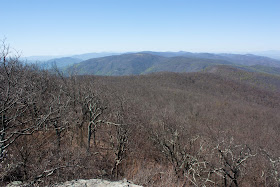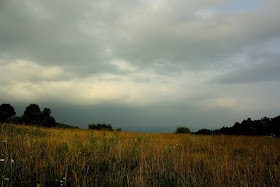 |
| Sawmill Run Overlook: Calf Mountain, Scott Mountain, and Big Levels |
7.9 miles loop, 1650 feet elevation gain
Difficulty: Moderate
The Turk Branch Loop is an enjoyable and scenic loop hike that combines a good amount of exercise with a few views, two streams, and a lot of forest. I did this hike during mid-spring and found it to be delightful because of the blooming wildflowers, but this hike might be less interesting in mid-winter or summer. The best view of this hike comes not from the trail itself but from the point where the trail crosses Skyline Drive at Sawmill Run Overlook. The trail is one of the many loops possible in the South District of the park and traverses a very lightly traveled area. Hiking Upward recommends doing this loop together with the trail to the summit of Turk Mountain. This would probably be a good combination, as the views from the top of Turk Mountain are superb and certainly more expansive that at any point on the Turk Branch Loop alone.
I headed out early on a Saturday morning to do this hike. I had originally hoped to wake up, eat breakfast, get gas, and then head to the Moormans River Overlook to watch the sunrise before hiking, but I managed to oversleep my alarm by a full hour and woke up just 45 minutes before the sunrise. Still hoping to catch the sunrise, I managed to get out of bed and into my car in five minutes and made my way to Beagle Gap Overlook, the first east-facing overlook on Skyline Drive, just three minutes before the sunrise.
The slopes of Calf Mountain were refreshingly green and the wispy fog covered much of the Piedmont. The sky glowed pink in the seconds before the sun peeked out from behind the ridge of Calf Mountain, bringing warmth and rays of light to the mountains. In the far distance, I could see the gap between Wolfpit and Carter Mountains, and the bowl in which Charlottesville lies.
 |
| Sunrise at Beagle Gap Overlook |
After watching the sunrise, I drove further along the drive to Jarman Gap, on the north side of Calf Mountain. I parked at the gap, around mile 97 of Skyline Drive. From the parking area, I followed the fire road at the entrance of the parking area downhill. The fire road immediately entered the forest and soon crossed the Appalachian Trail before crossing one of the small feeder streams of the South Fork Moormans River. I made my way quickly downhill, following alternate banks of the upper part of the South Fork Moormans River. The trail was grassy and lush and was lined with many wild geraniums. The fire road has no open views, but was enjoyable to hike along as it passed a clearing for a pipeline on its way down the South Fork Moormans Valley. The valley here was quite broad: even though the slopes of Bucks Elbow and Turk Mountain on either side were fairly steep, the area around the stream was wide and flat. I crossed the river three times; none of the crossings were difficult because the water levels were low, but the trail could be conceivably harder to hike during a rainstorm.
 |
| Dogwood blooming along the South Fork Moormans Fire Road |
 |
| Wild geraniums |
About 2 miles from the trailhead, I crossed the Turk Branch and reached the junction with the Turk Branch Trail. I ate a granola bar for breakfast there and admired the calm flow of the Turk Branch before heading up the Turk Branch Trail.
The Turk Branch Trail immediately began to climb, following its namesake stream uphill. In the first half mile after leaving the South Fork Moormans River, the trail passed by numerous small cascades on the Turk Branch, including one crossing at which there was a small waterfall flowing into a small pool. While trying to photograph this waterfall, I had a minor accident and slid into the Turk Branch- although I got soaked, I was thankful that my fall was into a small stream rather than off of a cliff!
 |
| The Turk Branch |
Past the crossing, the trail followed a tributary stream at a distance before turning toward the ridge and beginning a steeper ascent. After a fairly steep but short ascent, the trail crossed Turk Branch again and climbed onto the top of a ridge. After reaching the ridge, the trail became much flatter and much drier. The vegetation changed from deciduous to coniferous. There were some obscured views of Bucks Elbow and Middle Mountain through the trees. The geology here was also very interesting: while the rocks in the Moormans River valley and on the lower parts of the Turk Branch had been Catoctin greenstone, the rock on the higher slopes were clearly sedimentary. I later found that the trail passed through a band of the Weverton Formation. The Weverton Formation is the oldest of the three major formations of the Chilhowee Metasedimentary Group. Like the Hampton and Erwin formations found further west, the Weverton is a sedimentary layer set down during the Cambrian Era. Despite being sedimentary, the Weverton contains no fossils- the development of animal life occurred at roughly the time (or slightly after) the Weverton was set down, so in a way the Weverton is made of rock that is too old to have fossils!
 |
| Turk Branch Trail |
After 2.5 miles and 1200 feet of climbing from the Moormans River, I reached Turk Gap. I crossed Skyline Drive and began following the Appalachian Trail south. The remainder of the hike followed the AT, with views through the trees of Bucks Elbow, Pasture Fence, and Turk Mountains. After passing the turnoff for Turk Mountain, the trail began a descent through thickets of mountain laurel and forest floors of undergrowth. The mountain laurel on the trail here had already started budding, so it was perhaps less than two weeks until time for the mountain laurel to bloom. An early May bloom date is quite early for mountain laurel in Shenandoah!
After following the trail downhill for 1.7 miles from Turk Gap, I reached Sawmill Run Overlook. The overlook was about a hundred feet south of the point where the AT crossed the Drive, but I chose to make my way over to the overlook anyway for the spectacular view down Sawmill Run. From the overlook, Calf Mountain, a corner of Bear Den Mountain, Scott Mountain, Afton Mountain, and Big Levels near Waynesboro were visible. A beautiful dogwood tree bloomed right below the overlook itself. Green had finally reached the mountaintops here.
Past Sawmill Run Overlook, the trail began a small ascent onto a small knob on the ridgeline of the Blue Ridge crest. Over the remaining two miles back to Jarman Gap, there were numerous views through the trees and one decent view where the trees parted enough for a good view of Calf Mountain with Humpback Mountain poking out behind it.
 |
| View on the Appalachian Trail |
After descending from this ridge, the AT descended all the way down to the west bank of the South Fork Moormans River. I followed the phlox and spiderwort-lined trail back to its junction with the South Fork Moormans Fire Road and returned to my car at Jarman Gap. I unfortunately had to rush through many parts of the hike due to prior obligations in Charlottesville later that morning. Although this hike was very enjoyable and very beautiful, I had only three hours to do the entire eight-mile loop and so I was not able to stop and appreciate many of the finer points of the hike. However, this trail is certainly recommended, especially to hikers who have down the more popular trails in the park and hope to know the park well.
 |
| Phlox along the trail |












































